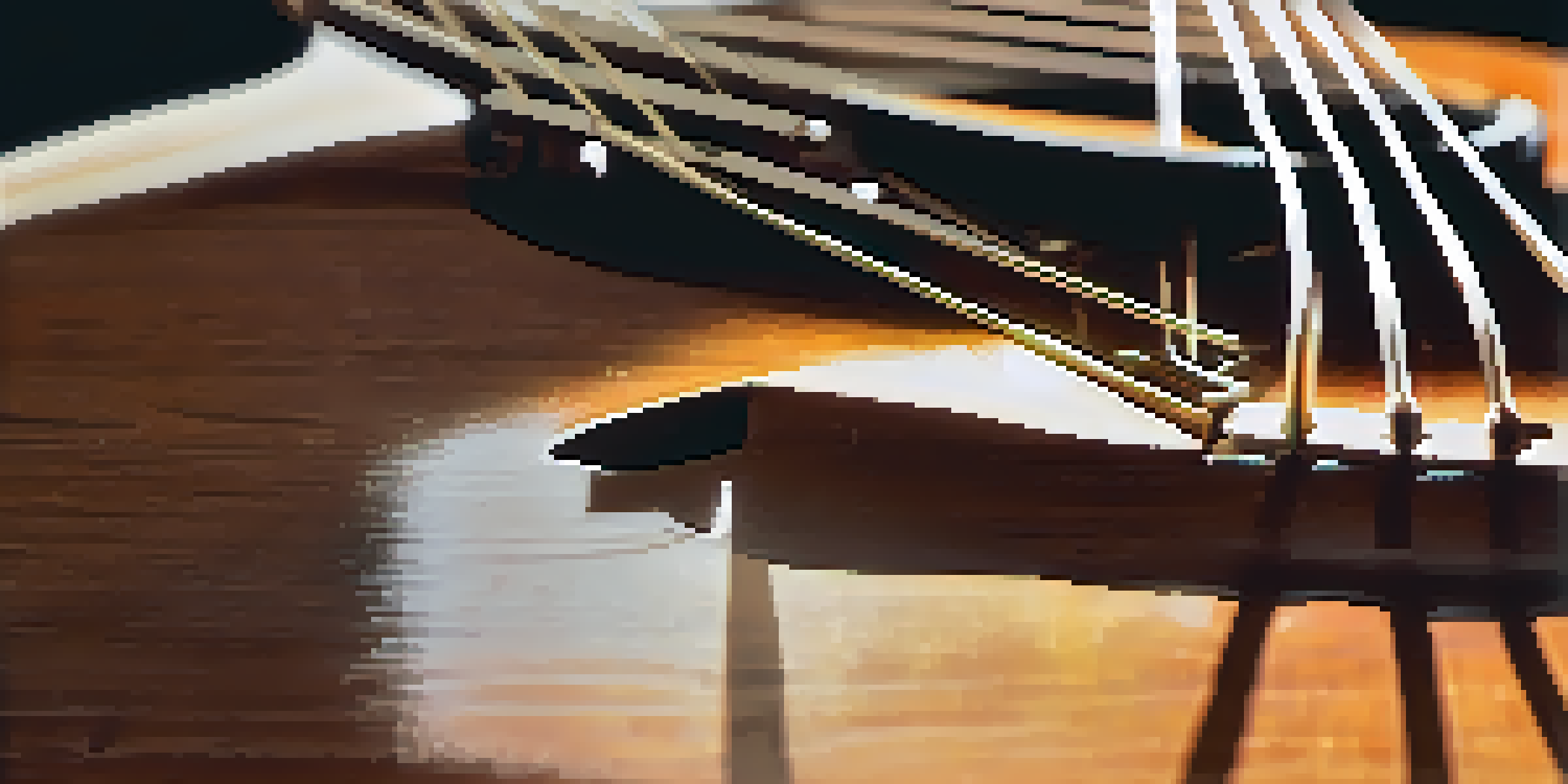The Art of Slide Guitar: Techniques for Unique Sounds

Understanding Slide Guitar: Origins and Influence
Slide guitar, a mesmerizing technique, has roots in blues and folk music, creating a unique voice that resonates with many. It involves using a slide, typically made of glass or metal, to glide over the guitar strings, producing a smooth and expressive sound. This style has influenced countless musicians, from Robert Johnson to modern rock icons, showcasing its versatility across genres.
Slide guitar is the most expressive of all guitar techniques, allowing players to convey deep emotions through its smooth, fluid sound.
The origins of slide guitar can be traced back to African American musicians in the early 20th century, who adapted traditional stringed instruments. They sought to emulate the human voice, leading to the development of techniques that allow for bending notes and creating vibrato. Understanding this historical context enriches your appreciation of the art form and its evolution.
Today, slide guitar continues to captivate audiences with its emotive power. It's a technique that allows for individual expression, inviting players to explore their unique sound. Whether you're a seasoned guitarist or a beginner, delving into slide guitar opens up new creative avenues for musical expression.
Choosing the Right Slide: Materials and Sizes Matter
Selecting the right slide is crucial for achieving the desired sound and feel. Slides come in various materials such as glass, metal, and ceramic, each offering distinct tonal qualities. For example, glass slides typically produce a smoother, warmer tone, while metal slides can yield a sharper, brighter sound.

Additionally, the size and weight of the slide can significantly impact your playing style. A heavier slide may provide more sustain, while a lighter slide allows for greater agility and speed. It's essential to experiment with different slides to find one that complements your technique and personal preference.
Slide Guitar's Rich History
Slide guitar has roots in early 20th-century African American music, evolving to create a unique sound that influences various genres.
Don't overlook the fit of the slide; it should be snug but comfortable on your finger. A well-fitted slide enhances your control and accuracy, enabling you to explore the full range of techniques available in slide guitar. Finding the perfect slide can be a game-changer in your musical journey.
Basic Techniques: Getting Started with Slide Guitar
Before diving into advanced techniques, it's important to master the basics of slide guitar. Start by placing the slide directly over the fret wire rather than between the frets. This positioning helps produce a clearer sound and allows for better intonation, making your notes resonate beautifully.
The slide guitar is a voice unto itself, capable of evoking the same emotion as the human voice.
Another foundational technique is to maintain a light touch when using the slide. Pressing too hard can create unwanted noise and diminish the smoothness of the notes. Instead, experiment with different pressure levels to find a balance that suits your style and enhances your tone.
Don’t forget about finger placement! Your fretting hand should support the slide hand by muting unwanted strings, which helps achieve a clean sound. Practicing these basic techniques will set the groundwork for more advanced slide guitar skills, allowing your creativity to flourish.
Advanced Techniques: Elevating Your Slide Guitar Skills
Once you're comfortable with the basics, it's time to explore advanced techniques that can elevate your slide guitar playing. Techniques like double stops, which involve playing two notes simultaneously, can add depth and complexity to your sound. This is especially effective in blues and country music, creating a rich harmonic texture.
Another advanced technique is the use of harmonics, where you lightly touch the string at specific points while sliding. This creates a bell-like tone, adding an ethereal quality to your playing. Combining harmonics with traditional slide techniques opens up a world of sonic possibilities.
Choosing the Right Slide Matters
The material and size of your slide can dramatically affect your sound and playing style, making experimentation essential.
Lastly, don't shy away from experimenting with alternate tunings. Many slide guitarists prefer open tunings, which allow for easier chord shapes and unique voicings. Exploring different tunings can inspire creativity and help you discover new sounds that resonate with your musical style.
Incorporating Dynamics: Expression in Slide Guitar
Dynamics play a vital role in slide guitar, allowing you to convey emotion and depth in your performance. Incorporating volume swells, where you gradually increase or decrease the volume while sliding, can create a dramatic effect. This technique adds a layer of expressiveness, making your playing more captivating.
Another dynamic technique is the use of vibrato, which involves varying the pitch of the note by moving the slide back and forth slightly. This adds a singing quality to your sound and can evoke a strong emotional response from your audience. Practicing vibrato will help you develop a personal touch to your slide guitar playing.
Lastly, consider the space between your notes. Pausing between phrases can create tension and anticipation, enhancing the emotional impact of your performance. By thoughtfully incorporating dynamics, you'll elevate your slide guitar playing and engage listeners on a deeper level.
Creating Unique Sounds: Effects and Pedals for Slide Guitar
To further enhance your slide guitar sound, consider incorporating effects pedals into your setup. Reverb and delay can add depth and atmosphere, transforming your tone into something truly unique. These effects can be particularly powerful in genres like ambient or psychedelic music, where soundscapes are key.
Overdrive and distortion pedals can also be beneficial, adding grit and sustain to your slide playing. This can create an exciting contrast, especially in rock or blues contexts. Experimenting with different effects can lead you to discover your signature sound, setting you apart from other musicians.
Dynamics Enhance Slide Playing
Incorporating dynamics like volume swells and vibrato adds emotional depth to your slide guitar performance.
Finally, don't overlook the importance of your amplifier settings. Adjusting EQ settings can significantly influence how your slide guitar sounds. Finding the right balance between treble, mid, and bass frequencies will help you achieve a tone that complements your playing style and the overall vibe of your music.
Learning from the Masters: Influential Slide Guitarists
One of the best ways to improve your slide guitar skills is to learn from the masters. Artists like Duane Allman, Derek Trucks, and Bonnie Raitt have all made their mark with unique slide techniques. Listening to their recordings and watching live performances can provide invaluable insights into their approaches and styles.
Analyzing their techniques can inspire you to experiment with your own sound. For instance, notice how Duane Allman uses melodic phrasing and dynamics to evoke emotion. Incorporating elements from their playing into your practice can help you develop your voice as a slide guitarist.

Additionally, consider transcribing their solos or licks. This process not only improves your ear but also deepens your understanding of slide guitar techniques. By studying the work of influential slide guitarists, you’ll be better equipped to forge your own path in this expressive musical art form.